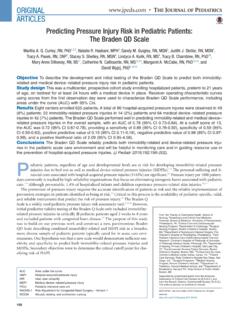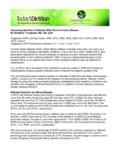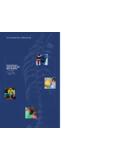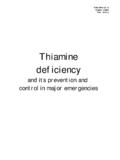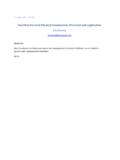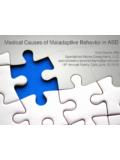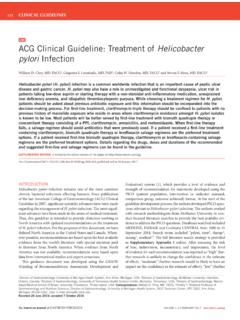Transcription of Using the Braden Q Scale to Predict Pressure Ulcer …
1 Using the Braden Q Scale to Predict Pressure Ulcer Risk inPediatric PatientsCatherine Noonan RN, MS, CPNP, CWONa, , Sandy Quigley RN, CPNP, CWOCNa,Martha Curley RN, PhD, FAANb,caDepartment of Nursing, Children's Hospital Boston, MAbCritical Care and Cardiovascular Program, Children's Hospital Boston, MAcUniversity of Pennsylvania School of Nursing, Philadelphia, PAKey words: Pressure Ulcer ;Risk assessment; Braden Q ScaleThe Braden Q Scale for Predicting Pediatric Pressure Ulcer Risk ( Braden Q Scale ) is a widely used,valid, and reliable pediatric-specific Pressure Ulcer risk assessment tool. Since its original publication,requests for clarification on how best to use the tool across the wide spectrum of pediatric patientscommonly cared for in health care systems have been received. Common clarifications focus on usingthe Braden Q Scale as originally designed; specifically, not Using untested derivations of the tool, andnot Using the Braden Q Scale to Predict medical device-related Pressure damage.
2 The purpose of thisarticle is to provide practical information on how best to use the Braden Q Scale and how to score apediatric patient's risk for Pressure ulcers. Accurate assessment of patient risk for Pressure ulcers is thefirst step in guiding appropriate nursing interventions that prevent Pressure ulcers. Patient assessment,scoring, and common clinical scenarios are presented. 2011 Elsevier Inc. All rights Pressure ULCERS is an importantphenomenon of concern to pediatric nurses. Pressure ulcersin this population represent a serious yet preventableiatrogenic injury. Numerous health care organizations tracktheir Pressure Ulcer prevalence rates to describe, in part, thequality of the nursing care they provide within theirinstitution. These data are also used to benchmark nursingcare quality across health care better understand an institution's Pressure Ulcer rate, itis also important to understand their patient populations'level of risk for Pressure ulcers. Successful Pressure ulcerprevention programs should be assessed from a perspectiveof identifying at-risk patients who remain Pressure Ulcer that describe Pressure Ulcer risk should Predict patientsat risk and patients not at risk for Pressure ulcerdevelopment.
3 Initiating Pressure Ulcer prevention strategiesfor at-risk patients , rather than all patients , will optimize theappropriate use of Braden Q Scale (Table 1) is a valid and reliablepediatric-specific Pressure Ulcer risk assessment tool. Sinceits original publication in 1996, the authors have receivednumerous requests for clarification on how best to use thetool across the wide spectrum of pediatric patients commonlycared for in pediatric health care organizations. The purposeof this article is to provide practical information on how bestto use the Braden Q Scale and how to score a pediatricpatient's Pressure Ulcer risk. Patient assessment, scoring, andcommon scenarios are of the Braden Q ScaleQuigley and Curley (1996)developed the Braden Q Scalefor Predicting Pediatric Pressure Ulcer Risk by adapting theadult-based Braden Scale for Predicting Pressure Sore Risk(Bergstrom, Braden , Laguzza, & Holman, 1987) with thepermission of its primary author (personal communication, Corresponding author: Catherine Noonan, RN, MS, CPNP, Noonan).
4 0882-5963/$ see front matter 2011 Elsevier Inc. All rights of Pediatric Nursing (2011)26, 566 575 Nancy Bergstrom, December 12, 1994). The adult-basedBraden Scale was selected because it was the most valid andreliable instrument at the time and also because it wasconstructed from a physiologically based conceptual frame-work that was population independent ( Braden & Bergstrom,1987). The framework identifies two critical determinants ofpressure ulcers: Pressure and tissue tolerance (Figure 1).Factors considered when assessing the intensity and durationTable 1 The Braden Q Scale for Predicting Pediatric Pressure Ulcer RiskFromQuigley and Curley (1996).567 Braden Q Scaleof Pressure include the patient's mobility, activity, andsensory perception. Intrinsic and extrinsic factors areconsidered when assessing the patient's tissue factors include the patient's ongoing nutritionalstatus, age, and tissue perfusion/oxygenation; extrinsicfactors include the skin's moisture and exposure to bothfriction and Braden Q Scale includes the six original Bradensubscales (mobility, activity, sensory perception, moisture,friction and shear, and nutrition) but adds a seventhsubscale, that is, tissue perfusion/oxygenation.
5 The BradenQ Scale modifications of the adult-based tool reflect theunique developmental characteristics of pediatric patients ,the prevalence of gastric/transpyloric tube feedings, andthe availability of blood studies and noninvasive technol-ogy in the acute care pediatric setting. Adding the tissueperfusion/oxygenation subscale was also consistent withBraden and Bergstrom's original conceptual framework(1987) and optimizes the use of data common to acutecare Braden Q Scale was validated in 2003 in a multisiteprospective cohort descriptive study of 322 pediatric intensivecare patients who were on bed rest for at least 24 hours (Curley,Razmus, Roberts, & Wypij, 2003). This study established thepredictive validity of the Braden Q Scale in acutely ill pediatricpatients and identified the critical cutoff for classifying patientrisk as a score of 16. At a score of 16, the sensitivity of theBraden Q Scale is 88% and the specificity is 58% (Box 1).These data are consistent with those reported for the predictivevalidity of the Braden Scale (with cutoff scores 16 18) invarious adult patient populations within tertiary care settings(Bergstrom, Braden , Kemp, Champagne, & Ruby, 1998);specifically, the Braden Scale sensitivity ranges from 38% to88%, and its specificity ranges from 68% to 92%.
6 The Braden Q Scale was validated in pediatric patients 3weeks to 8 years of age. The specific age of 21 postnatal dayswas selected because at 3 weeks of age the skin reachesrelative maturity comparable to a full-term infant, regardlessof the infant's gestational age at birth (Malloy & Perez-Woods, 1991). The selection of 8 years of age reflectedconventional norms; specifically, in 1994, the AmericanHeart Association considered patients older than 8 years tobe an adult in terms of treatment (Chameides & Hazinski,1994). patients with congenital heart disease were excludedbecause the impact of chronic hypoxemia on Pressure ulcerdevelopment was unclear. An opportunity exists to furthervalidate the Braden Q in the preterm and neonatal population(less than 21 postnatal days), in the adolescent and youngFigure 1 The conceptual framework identifying etiological factors of Pressure ulcers. Adapted fromBergstrom, Braden , Laguzza, andHolman (1987).Box 1 What do the numbers mean?Sensitivity is the percentage of patients who developeda Pressure Ulcer who were assessed as being at risk fora Pressure Ulcer .
7 Good sensitivity indicates truepositives while minimizing false negatives. Specificityis the percentage of patients who do not develop apressure Ulcer and who were assessed as being not atrisk for developing an Ulcer . Good specificity identifiestrue negatives and minimizes false positives (Ayello & Braden , 2002). The patient benefit of preventingpressure ulcers in an at-risk group exceeds the patientrisk of implementing prevention interventions in a low-risk group; thus, a high sensitivity is desired in apressure Ulcer risk assessment tool ( Braden andBergstrom, 1994). Complete balance between sensitiv-ity and specificity cannot be Noonan et population, and in the patients with congenital heartdisease. The Braden Q Scale is specifically designed topredict pediatric Pressure Ulcer risk. Other metrics are moregeneral and combine Pressure Ulcer risk and risk of othertypes of skin injuries (Bolton, 2007; Gray, 2004; Willock,Anthony, & Richardson, 2008).Scoring the Braden Q ScaleThe Braden Q Scale is composed of seven subscales.
8 Allseven subscales are rated from 1 (least favorable)to4(mostfavorable); patients receive only one score per subscale. TotalBraden Q Scale scores range from 7 (highest risk)to28(lowestrisk), with a score of 16 or lower identifying pediatric patientsat risk for Pressure ulcers (Curley et al., 2003). In both theBraden and Braden Q Scales, a higher score generally indicateshealthier patient condition and function. patients are scored byphysical assessment, patient/parent interview, and chartreview. Each subscale is presented in the following the patient's ability to independently changeand/or control their body position. Descriptors range fromcompletely immobile(1) tono limitations(4). Repositioningby the caregiver (such as parent or nurse) is not includedwhen evaluating the patient's independent level of can be assessed in any location, for example, intheir bed/crib, chair/infant seat, limitations. Makes major and frequent changes inposition without limited. Makes frequent although slightchanges in body or extremity position limited.
9 Makes occasional slight changes in bodyor extremity position but unable to completely turn immobile. Does not make even slight chan-ges in body or extremity position without do I score these common scenarios?Score 3-Month infant with good head control who can rollover front to back but not back to front4 Patient moves independently4 Epidural catheter for pain control, decreasedmovement of lower extremities, able to move rest ofbody well3 Child able to make slight changes on own but needsassistance to fully turn2 Hemiparesis, one side with decreased/no function(regardless of age)2 Lower body paralysis, able to move and transfer(regardless of age)2 Postoperative patient in lower extremity traction2 Child with baseline neuromuscular weakness whocan make slight changes in position but cannot turnself, sit unassisted, or walk2 Patient in total body cast (spica) who cannot makeeven slight changes in body position and is turnedby caregiver1 Patient intubated and receiving neuromuscularblockade to support ventilation1 Patient requiring assistance for all turns1 ActivityDefinitionDescribes the patient's current degree of physical range frombedfast(1)
10 Towalks frequentlyorpatient too young to ambulate(4).AssessmentInterview the primary caregiver about the patient'sbaseline developmental ability to ambulate. Activity isassessed from a developmental perspective, for example,many toddlers take their first steps between 9 and 12months of age, cruise by moving on two feet while holdingonto stationary objects, then walk independently by thetime they are 15 months old. The Braden Q's activitysubscale is scored based on the patient's acquisition of thesedevelopmental milestones by 15 months of age. After 15months of age, all patients are scored on their currentactivity/ability to patients too young to ambulate OR walks outside the room at least twice a day and insideroom at least once every 2 hours during waking occasionally. Walks occasionally during day,but for very short distances, with or without majority of each shift in bed or fast. Ability to walk severely limited ornonexistent. Cannot bear own weight and/or must beassisted into chair or Confined to do I score these common scenarios?
